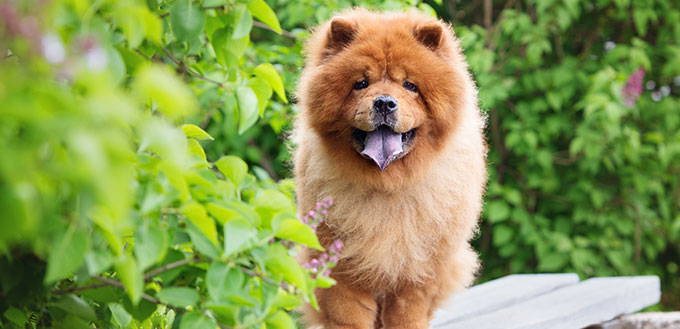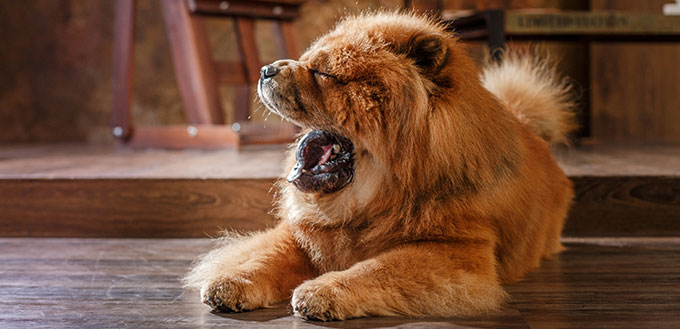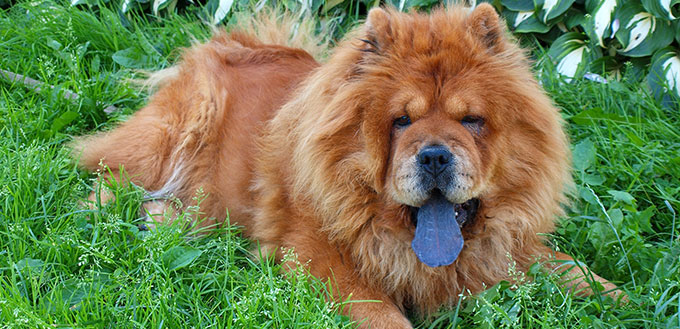It’s hard to mix a chow-chow off with any other breed of dog, their main-like fur and teddy bear appearance is quite unique, and something that has made them extremely popular throughout history. In fact, one emperor during the Tang Dynasty was so fond of the Chow Chow dog breed that he had arranged to have 10000 men trained with 5000 Chows as a primary method of hunting.
However, the most standout feature on a Chow Chow is the fact that they have blue tongues and lips, Or in some cases black. Many people over the years have wondered over the hears how this blue tongue dog got this most unique feature, and the answer might surprise you.
Why do Chows Have Blue Tongues?
According to Banghart, there appears to be “no documentation of why Chow Chows have blue tongues”, even despite their lengthy recorded history going as far back as 206 BC China. There are however several fictional explanations that have been concocted throughout history such as:
- They licked the sky: This rather romanticized explanation goes back to the creation of the world, in which Chow Chows had been allowed to lick up any pieces of the blue sky that had fallen to earth during the time in which the stars were set in their place.
- They’re not just dogs: Another story theorizes that Chow Chows inherited their tongues from bears, this stems from their bear-like appearance.
Whatever the reason for this hereditary abnormality, not history nor science has been able to figure out from where the blue tongue originates.
One thing we do know is that Chow Chow’s were exhibited at the London Zoo around the 1820s as “The Wild Dogs of China”, during which time the caretaker had noticed that their mouth and tongue had a black-blue coloring. apparently once managed reading had begun the unique characteristic of the black-blue tongue was listed as a breed standard requirement for a way to identify purebred Chow Chow offspring.
Are Chow Chows Born with Blue Tongues?
When you hear the words “dog breed with blue tongue”, it may make you think that there is something wrong with them, or perhaps that it was done to them by their owner for aesthetic reasons, especially since the Chow Chow isn’t actually born with a blue tongue, but rather a pink one like any other puppy.
Similar to how a dog can change its fur pattern as it’s growing in its coat, the pigment cells in a Chow Chow’s tongue simply haven’t matured to be the blue-black color expected by their breed standard.
Typically a Chow Chow tongue will take up to 6 months to fully developed the dark blue pigment that dog lovers know so well, and is a completely natural part of their development.
“A Chow Chow with incomplete pigment won’t be eligible to compete in conformation dog shows and is disqualified from the breed standard.” says Banghart.
What’s the difference between a blue tongue and blue or black spots?
Have you ever heard somebody refer to a dog as “part Chow” when they have blue or black spots on their tongue? Understandably this stems from the fact that Chow Chows are known for their black-blue tongues, and so it stands to reason that people would assume that a dog must have Chow Chow genes if they show that coloration on their tongue as well.
This isn’t actually true, and while black-blue tongue can be a sign that’s a dog has got some Chow Chow somewhere in its bloodline, this is not always a guaranteed indicator. There are, in fact, a large number of dog breeds, particularly pure breeds, such as the Newfoundland and Labrador Retriever that can develop spots on their tongues, however, this is simply a fluke tongue pigment caused by random pigmentation in the skin cells rather than being a hereditary trait.
Other Dog Breeds With Dark Tongues
In the canine world, there is only one other breed of dog which has this extremely unusual characteristic, and that is the Chinese Shar-Pei. Much like with Chow Chows, no amount of research has revealed by the Chinese Shar-Pei also has a blue-black tongue, the only thing linking the two dog breeds is that they both originated in China and share distant ancestry, though this does not explain why only these two dog breeds have blue-black tongues.
Though there are quite a few dog breeds that can carry a predisposition to developing tongues with dark spots or patches. Having a dark-spotted tongue can make them look like a purple tongue dog, but this is just a trick of the pigmentation. Here are some of the dog breeds that have been known to crop up with spotted tongues in the past:
- Thai Ridgeback
- Airedale
- Tibetan Mastiff
- Australian Cattle Dog
- Mountain Cur
- Fila Brasileiro
- Belgium Malinois
- Black Russian Terrier
- Gordon Setter
- Dalmatian
- Bouvier de Flandres
- Kai Ken
- Shiloh Shepherd
- Soft-Coated Wheaten Terrier
Interestingly, dogs with this tendency don’t class as blue-tongued dogs, but rather it is seen as a pigmentation fluke, that is because it is not a hereditary guarantee, and does not carry throughout the line, it is simply a special feature of that particular pooch.
FAQ’s:
Q: Do all chows have blue tongues?
A: Yes, Although the origin of the black-blue tongue is unknown, it is with absolute certainty that we can say all purebred Chow Chows must have black-blue tongues. It is considered one of the defining characteristics of the breed and is completely unique to Chow Chow physiology, and is an essential feature required during the breeding process, to ensure a pure lineage.
Q: Are Chow Chow tongues really poisonous?
A: Absolutely not, it is not known where this unusual and farfetched urban myth has come from, all we do know is that it is one of those myths which has circulated all over the world. We are here to say once and for all that the Chow Chow’s tongue is not poisonous. This is purely a completely fabricated rumor invented to make the Chow Chow dog breed appear more dangerous than it actually is.
It is unknown why somebody would want to start such a ridiculous yet potentially damaging rumor, but fortunately, it is widely dismissed and hopefully, with the correct information, will be a myth that dies out.
Q: Are chows The only dogs with black tongues?
A: Even though a full blue-black tongue is unique to the Chow Chow and Chinese Shar-Pei along with several other animals such as the polar bear, giraffe, Jersey, and several other cattle breeds, it may surprise you to know that there are more than 30 purebred dog breeds known that can develop blue or black spots on their tongues.
Q. Can a Chow Chow’s tongue be any other color?
A: No, the only pigmentation a Chow Chow can develop is blue, though they are born with pink tongues, its pigment will change by the time they are 6 months old. Once the shift in color is complete, there should be no pink spots or patches left on their tongue. Their gums will also shift in color to match the pigment of their tongue.
Q. Does a Chow Chow’s tongue require any special care?
A: Not at all, a Chow Chow’s tongue is just like any other dog, it is not more sensitive and does not cause them any pain, so you do not need to worry about buying special food or toys for them. Just treat them as you would any other dog.
Sources:
- 5 Fun Facts About the Chow Chow, PetMD
- Chow Chow, VCA Hospitals







